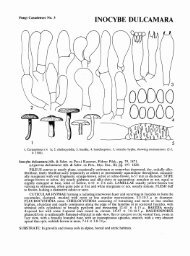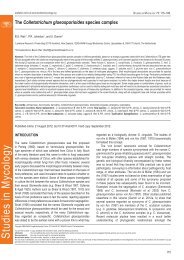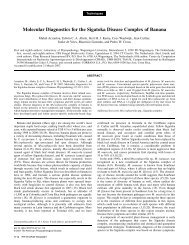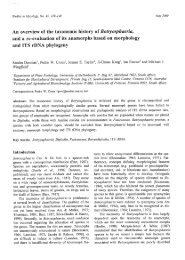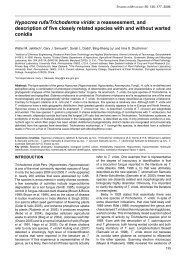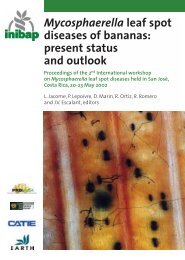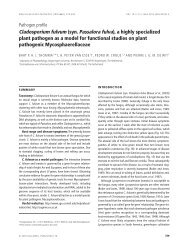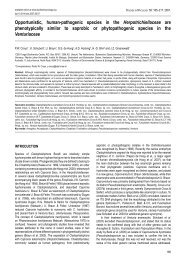Acremonium phylogenetic overview and revision of ... - CBS - KNAW
Acremonium phylogenetic overview and revision of ... - CBS - KNAW
Acremonium phylogenetic overview and revision of ... - CBS - KNAW
Create successful ePaper yourself
Turn your PDF publications into a flip-book with our unique Google optimized e-Paper software.
www.studiesinmycology.org<br />
acremonium phylogeny<br />
Fig. 3. A. Trichothecium roseum <strong>CBS</strong> 113334 showing retrogressive conidiation. B-D. conidiogenesis in “Trichothecium indicum”/ Leucosphaerina indica <strong>CBS</strong> 123.78 showing<br />
retrogressive development (B), phialidic development (B) <strong>and</strong> sympodial development (D).<br />
would replace the familiar "T. roseum" with a Leucosphaerina<br />
name. A system that retains primacy for morphology, which is<br />
the only reasonable basis for dual nomenclature in the molecular<br />
era, would divide the Trichothecium clade into four genera, as<br />
is the case today. One <strong>of</strong> those genera, <strong>Acremonium</strong>, would be<br />
quintessentially artificial <strong>and</strong> almost completely divorced from<br />
evolutionary biological relationships. With increased emphasis on<br />
genomes, proteomes, <strong>and</strong> metabolomes, a focus on polyphyletic<br />
elements <strong>of</strong> microscopic shape seems counterproductive. Every<br />
new system <strong>of</strong> nomenclatural change will entail both fortunate <strong>and</strong><br />
infelicitous changes <strong>and</strong> will receive some resistance in scientific<br />
communities. A nomenclatural system based on phylogeny will be<br />
considerably more stable than any previous system. The interests<br />
<strong>of</strong> all would be best served if it bridged gracefully out <strong>of</strong> pre<strong>phylogenetic</strong><br />
taxonomy, preserving as many familiar elements as<br />
possible. Trichothecium roseum, a constant from 1809 to today, is<br />
one <strong>of</strong> those elements that is worthy <strong>of</strong> being preserved.<br />
The small, tightly unified clade <strong>of</strong> Trichothecium includes<br />
isolates with three different anamorphic forms, currently classified as<br />
<strong>Acremonium</strong> (phialoconidia), Spicellum (sympodial blastoconidia),<br />
<strong>and</strong> Trichothecium (retrogressive blastoconidia). The associated<br />
teleomorph, Leucosphaerina indica, produces anamorphic forms<br />
described as “<strong>Acremonium</strong> or Sporothrix” (Suh & Blackwell 1999).<br />
These morphs are illustrated by von Arx et al. (1978). The range <strong>of</strong><br />
anamorphic forms produced by L. indica overlaps those produced<br />
by all the anamorphic species in the clade (Fig. 3).<br />
The four species studied here, Trichothecium roseum,<br />
<strong>Acremonium</strong> crotocinigenum, Leucosphaerina indica, <strong>and</strong> Spicellum<br />
roseum, have recently been associated with a fifth, newly described<br />
species, Spicellum ovalisporum. The dendrogram produced by<br />
Seifert et al. (2008) makes it clear that S. ovalisporum is related to<br />
S. roseum <strong>and</strong> is certainly a member <strong>of</strong> the Trichothecium clade. In<br />
parallel with the <strong>revision</strong> <strong>of</strong> the genus Microcera by Gräfenhan et al.<br />
(2011), this clade is redefined here as a genus with the oldest valid<br />
generic name, Trichothecium.<br />
As Fig. 2 shows, the second described Leucosphaerina<br />
species, L. arxii, is in the distant <strong>Acremonium</strong> pinkertoniae clade<br />
<strong>and</strong> is closely related to Bulbithecium hyalosporum. Malloch (1989)<br />
commented that it differed from L. indica by lacking sheathing gel<br />
around the ascospores <strong>and</strong> by having an <strong>Acremonium</strong> anamorph.<br />
Trichothecium Link : Fr., Mag. Gesell. naturf. Freunde,<br />
Berlin 3: 18. 1809.<br />
= Spicellum Nicot & Roquebert, Revue Mycol., Paris 39: 272. 1976 [1975].<br />
= Leucosphaerina Arx, Persoonia 13: 294. 1987.<br />
Older synonymy for the genus is given by Rifai & Cooke (1966).<br />
Colonies on malt extract agar 20–40 μm after 7 d at 24 °C, white<br />
to salmon orange or salmon pink (Methuen 6-7A2, 4-5A2-3), felty,<br />
floccose or lanose, sometimes appearing powdery with heavy<br />
conidiation. Ascomatal initials, if present, produced on aerial<br />
mycelium, irregularly coiled. Ascomata spherical or nearly so, nonostiolate,<br />
colourless or slightly pink, 150–300 μm; ascomatal wall<br />
persistent, nearly colourless, 10–13 μm thick, <strong>of</strong> indistinct hyphal<br />
cells; asci uniformly distributed in centrum, clavate to spherical,<br />
with thin, evanescent walls, 8-spored, 10–13 μm wide; ascospores<br />
ellipsoidal or reniform, with refractile walls <strong>and</strong> a 1–1.5 μm broad<br />
gelatinous sheath, smooth or finely striate, hyaline, yellow to pink en<br />
masse, without germ pore, 6–7 × 3–4 μm. Conidiogenous apparatus<br />
varying by species, featuring one or more <strong>of</strong>: conidiophores up to<br />
125 μm long × 2–3.5 μm wide, septate, unbranched, with terminal<br />
phialides 10–65 μm long, producing unicellular, hyaline, smoothwalled<br />
phialoconidia, obovate, oblong or cylindrical 4.4–7.4 μm; or<br />
conidiophores up to 175 μm long, unbranched or uncommonly with<br />
one or more branches, retrogressive, shortening with production<br />
<strong>of</strong> each conidium, with each conidial base subsuming a portion <strong>of</strong><br />
conidiophore apex; conidia 0–1-septate, ellipsoidal or ovate, with a<br />
decurved, abruptly narrowed basal hilum terminating in a distinct<br />
truncate end, 5–12 × 3–6.5 μm; or conidiophores ranging from<br />
unicellular conidiogenous cells to multicellular, multiply rebranched<br />
apparati extending indefinitely to beyond 200 μm long; terminal<br />
cells 9–37 μm long with a cylindrical basal part <strong>and</strong> a narrowing,<br />
apically extending conidiogenous rachis sympodially proliferating<br />
<strong>and</strong> producing oval to ellipsoidal to cylindrical or allantoid conidia<br />
3.5–11 × 1.5–3.5 μm, with truncate bases. Chlamydospores absent<br />
159




